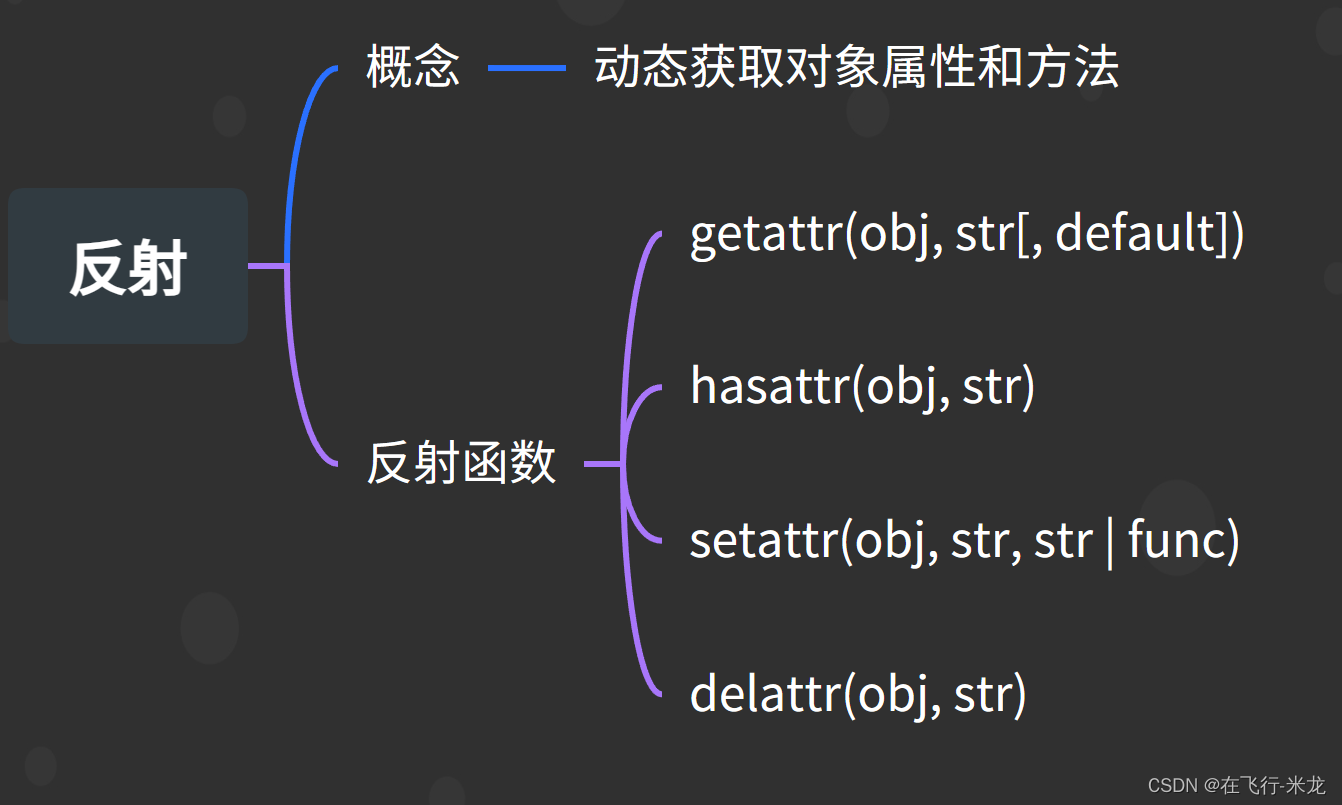Python 面向对象之反射
【一】概念
- 反射是指通过对象的属性名或者方法名来获取对象的属性或调用方法的能力
- 反射还指的是在程序额运行过程中可以动态获取对象的信息(属性和方法)
【二】四个内置函数
-
又叫做反射函数
-
万物皆对象(整数、字符串、函数、模块、类等等)
-
万物皆对象(整数、字符串、函数、模块、类等等)
-
万物皆对象(整数、字符串、函数、模块、类等等)
-
这里提到的对象都是大概念的对象
【1】hassttr
(1)概念
-
hasattr(object, str) -
判断对象是否有相应的属性或者方法
-
第一个参数是对象,第二个参数属性或者方法的字符串
-
返回值为
bool值,有则True,无则False -
注意:类无法找到实例属性
(2)代码
class A:
name = "bruce"
def __init__(self):
self.age = 18
def eat(self):
print(f"{self.name}eating")
# 查看类是否具有相应属性和方法
print(hasattr(A, "name")) # True
print(hasattr(A, "age")) # False
print(hasattr(A, "eat")) # True
# 查看对象是否具有相应属性和方法
a = A()
print(hasattr(a, "name")) # True
print(hasattr(a, "age")) # True
print(hasattr(a, "eat")) # True
【3】getattr
(1)概念
-
getattr(object, name[, default]) -
获取对象的属性或者方法
-
第一个参数是对象,第二个参数属性或者方法的字符串,第三个参数是找不到返回的默认值
-
返回值为属性或者方法或默认值,找不到也没有默认值会报错
(2)代码
class A:
name = "bruce"
def __init__(self):
self.age = 18
def eat(self):
print(f"{self.name} is eating")
a = A()
print(getattr(a, "name")) # bruce
print(getattr(a, "age")) # bruce
res = getattr(a, "eat") # # <bound method A.eat of <__main__.A object at 0x000>>
res() # bruce is eating
# getattr(a, "nname") # 报错
print(getattr(a, "nname", "找不到")) # 找不到
【3】setattr
(1)概念
-
setattr(object, str) -
设置对象的属性或者方法
-
第一个参数是对象,第二个参数是属性的字符串或者方法地址
-
已有就修改,没有就添加
-
注意:给实例添加的方法是属性
(2)代码
class A:
name = "bruce"
def __init__(self):
self.age = 18
def eat(self):
print(f"{self.name} is eating")
a = A()
setattr(a, "name", "lily")
print(getattr(a, "name")) # lily
setattr(a, "age", 20)
print(getattr(a, "age")) # 20
def func(self):
print("类外的函数1")
# 给实例添加的一个属性,他是方法
setattr(a, "func", func)
print(a.__dict__) # {'age': 20, 'name': 'lily', 'func': <function func at 0x000>}
a.func(a) # 类外的函数1
def func(self):
print("类外的函数2")
# 给类添加了一个方法
setattr(A, "func", func)
A.func(a) # 类外的函数2
a.func(a) # 类外的函数1
【4】delattr
(1)概念
-
delattr(object, str) -
删除对象的属性或者方法
-
第一个参数是对象,第二个参数是属性或者方法的字符串
-
没有返回值,删除没有的会报错
-
注意:通过实例无法删除类属性或者方法
(2)代码
class A:
name = "bruce"
def __init__(self):
self.age = 18
def eat(self):
print(f"{self.name} is eating")
# 对属性操作
a = A()
# delattr(a, "name") # 无法删除
delattr(a, "age")
print(getattr(a, "age", "找不到")) # 找不到
delattr(A, "name")
print(getattr(A, "name", "找不到")) # 找不到
# 对方法操作
a = A()
# delattr(a, "eat") # 无法删除
print(getattr(A, "eat", "找不到")) # 找不到
【三】应用
【1】反射当前模块成员
- 用于查看当前模块下的
import sys
class A:
pass
class B(A):
pass
def func():
pass
module_member = sys.modules[__name__]
print(module_member)
# <module '__main__' from 'D:\\Python\\PythonProjects\\My_projects\\tets_tempory\\main.py'>
print(hasattr(module_member, "B")) # True
print(hasattr(module_member, "func")) # True
【2】动态导入模块
- 通过
importlib模块导入所需要的模块,通过ImportError异常判断模块是否能导入 - 通过
getattr反射获取模块的方法,通过AttributeError异常判断该模块是否具有这个方法
import importlib
module_name = input("module name:>>>")
method_name = input("method name:>>>")
try:
module = importlib.import_module(module_name)
method = getattr(module, method_name)
method()
except ImportError:
print("module not found")
except AttributeError:
print("method not found")
【3】动态创建对象
class FirePeaShooter:
def introduce(self):
print("I`m FirePeaShooter")
class IcePeaShooter:
def introduce(self):
print("T`m IcePeaShooter")
type = input("input type (fire or ice):>>>")
global_class = globals()
if "fire" in type:
class_type = "FirePeaShooter"
obj = global_class[class_type]()
obj.introduce()
elif "ice" in type:
class_type = "IcePeaShooter"
obj = global_class[class_type]()
obj.introduce()
else:
print("wrong")
【四】总结























 247
247











 被折叠的 条评论
为什么被折叠?
被折叠的 条评论
为什么被折叠?








